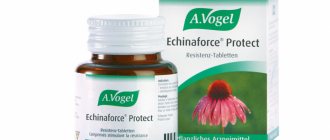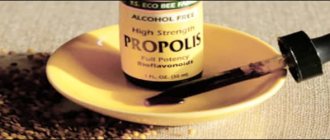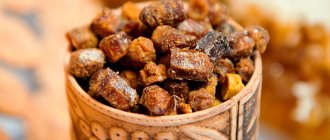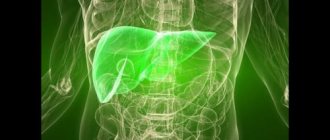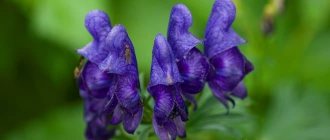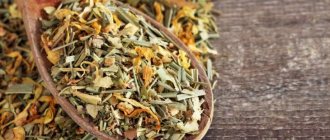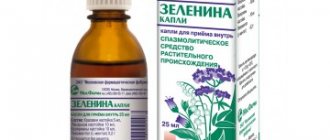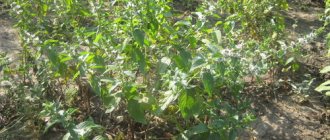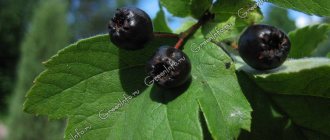The Soviet Union produced a fairly large assortment of alcoholic beverages. Including tinctures with decent taste characteristics based on natural plant materials. One of the popular tinctures was mint, which belongs to the “bitters” group.
Its pleasant soft taste fits perfectly into any feast, a warm meeting with friends or a fun cocktail party. However, as now. All that remains is to find a high-quality tincture without artificial flavors on store shelves, which is quite difficult. Therefore, I think the best option is to prepare mint tincture at home.
Among modern alcoholic drinks, mint tincture is comparable to the famous Finnish mint vodka, or it would be more correct to call mint liqueur Minttu.
.
We will consider the classic Soviet recipe for mint tincture in this article.
Let's start by choosing the main component - mint.
Useful properties of tincture
Peppermint is a herbaceous cultivated plant that was developed by hybridizing several wild species. Today, mint can be found everywhere in gardens and vegetable gardens, and some selected varieties are cultivated on an industrial scale.
Man first began to use mint back in the days of Ancient Rome. At first it was used as a seasoning in cooking, then in perfumery - for example, mint was used to rub tables to make guests feel more comfortable. The medicinal properties of the plant were discovered a little later.
The beneficial properties of mint are due to its unique chemical composition. The leaves of the plant contain:
- amino acids;
- vitamins;
- tannins and resins;
- fixed oils;
- menthol;
- flavonoids;
- essential oils, etc.
Medicines based on mint have antispasmodic, sedative, choleretic, anti-inflammatory and antisemitic effects. It is used to treat gastrointestinal pathologies, colds and in cosmetology.
What does it help with?
Tinctures and decoctions based on mint have local irritant, sedative, choleretic, antispasmodic, antiemetic and analgesic effects. So what does mint help with? Mint tincture is used for the following diseases:
- digestive disorders;
- flatulence;
- heartburn - in some cases the opposite effect occurs, increasing the symptom;
- nausea;
- neuralgia;
- stress and insomnia;
- angina pectoris;
- hypertension;
- for renal and intestinal colic;
- headache and toothache;
- respiratory tract diseases.
Mint is also used as a sedative during menopause or as a local anesthetic and antiseptic for the treatment of purulent wounds and burns. Promotes rapid tissue regeneration.
The tincture can be used to stimulate hair growth, and also as a mouth rinse to prevent diseases of the teeth and gums.
Cooking recipes
Folk and traditional medicine has many different recipes for preparing mint-based tinctures and decoctions. The pharmaceutical industry is actively producing an alcohol version. It is this form, according to scientists, that has the greatest extraction of beneficial substances and, accordingly, has the best therapeutic properties.
Moreover, the alcohol base of the drug facilitates long-term storage of the product , which facilitates the transportation and sale of products. You can purchase the factory-made drug at any pharmacy chain, or you can make an analogue of the product at home yourself.
Traditional medicine, in addition to alcohol tinctures, has recipes for water decoctions. The use of such decoctions is recommended for persons, for example, with peptic ulcers or other diseases for which the use of alcohol-containing substances is prohibited.
Classic alcohol tincture
The classic factory tincture contains only three ingredients: peppermint leaves and oil, as well as 90% alcohol. To prepare 500 ml of tincture you will need:
- 25 g each of oil and peppermint leaves;
- 90% alcohol – 490 ml.
All components are mixed and infused for a week. Harvesting leaves should be done in dry weather, during the period when approximately half of the plant blooms.
Cooking technology
The ingredients to create homemade mint tincture will require:
- Rectified ethyl alcohol 96.6% vol.
- Peppermint
- Caraway
The mint tuning technology can be described point by point:
- Preparation of mint infusion
- Preparation of aromatic alcohol
- Blending of ingredients
Let's proceed to each stage and start with creating a mint infusion.
Mint infusion
To prepare mint infusion you will need the following ingredients:
- caraway seeds – 50 g
It will add piquancy and enhance the flavor of the tincture.
- fresh peppermint – 30 g
- water-alcohol mixture 50% vol. — 3 l
The creation of mint infusion is based on an extraction process, as a result of which the components of the original plant material are transferred into the extractant (ethyl alcohol). This means that after extraction, the components contained in plant raw materials (essential oils, pigments, salts, carotenoids, alkaloids and other substances) will go into an alcohol solution and will be very tasty.
One important rule applies here: the brighter the aroma of the raw materials, the richer the final product will be! Therefore, if possible, use only the best high quality raw materials. Selected cumin without any foreign musty or moldy odors. Regarding peppermint, I recommend fresh mint if possible. If you don't have it on hand, take it dry. Just remember that the flavor of the tincture will be weaker due to drying, storage and external factors.
We prepare mint infusion using the direct infusion method - all ingredients are mixed in one container. For better extraction of components, mint and cumin are crushed.
Next, pour the ingredients into a 13 liter still “Doctor Guber” 2.0.
Fill with a water-alcohol mixture with a strength of 50% vol.
Mix thoroughly using a Dr. Guber stirrer.
Let it brew for 12 hours at room temperature with the tank lid closed.
Next, we proceed to obtaining aromatic alcohol.
Aromatic mint alcohol
As the main equipment for fractional distillation of mint infusion, we use the “Midget 2.0” universal moonshine still, the design of which is based on patented technology.
The assembly of the device is quite ingeniously simple and very functional.
Includes:
- still “Doctor Guber” 2.0
- copper cap levels “mono-aroma”
- viewing diopters 3"
- head "Midget 2.0"
- glass with aftercooler 2.0
Temperature control in the tank and column is carried out using analog thermometers.
The heating source is a Gastrorag induction cooker.
Operating power: 1.5 kW.
How to use
Instructions for using peppermint tincture depend on the disease and the type of drug. The standard dose of alcohol tincture for persons over 12 years of age is no more than 15 drops. Single dose for oral administration of other types of tinctures:
- vodka tincture – 20 – 25 drops;
- mint water – 1 cup;
- water decoction – 50 – 100 ml;
- Corvalol with mint – 15 – 30 drops.
The drugs must be taken 3 times a day before meals. The duration of the course is no more than two weeks. Next, to avoid the body getting used to it, you should take a break for at least 1 week. Before starting treatment, you should consult your doctor.
For hair
Tinctures and decoctions based on mint are often used for hair care. The products are used to eliminate dandruff, stimulate hair growth and give hair a healthy look. So, how to use peppermint tincture for hair? This can be done in several ways:
- to stimulate hair growth, dilute the alcohol tincture with water in a 1:1 ratio. Using a cotton swab, the product should be applied to the scalp twice a week;
- for oily hair - when washing your hair, it is recommended to add 10-20 drops of alcohol tincture or 100-150 ml of water decoction to the rinse water;
- against dandruff - after washing your hair with shampoo, it is recommended to apply a water decoction of mint to the scalp, hold for 1 - 2 minutes, rinse with running water.
Peppermint tincture
Registration number: P N001599/01
Trade name: Peppermint tincture.
INN or group name: Peppermint leaves.
Dosage form: Tincture.
Composition: Active substances:
- Peppermint leaves - 50 g
- Peppermint oil – 50 g
Excipients:
- Ethanol (ethyl alcohol) 90% - sufficient amount to obtain 1000 ml of tincture.
Description: Transparent liquid from light green to dark green color, with the smell of peppermint.
Pharmacotherapeutic group: Antispasmodic agent of plant origin.
ATX code: A03
Pharmacological action: Has a moderate antispasmodic effect on the gastrointestinal tract and a mild sedative effect; has choleretic properties.
Indications for use: Used as a symptomatic remedy for nausea, vomiting, spasms of smooth muscles of the gastrointestinal tract. The course of treatment is 1 - 2 weeks.
Contraindications: Hypersensitivity to the components of the drug, age under 18 years.
With caution: Liver disease, alcoholism, traumatic brain injury, brain disease.
Use during pregnancy and lactation: The drug contains ethyl alcohol. Not recommended for use during pregnancy and lactation.
Directions for use and dosage: Inside. Adults are prescribed 10-15 drops per dose (until symptoms disappear, but no more than 3-4 times a day). Side effects Allergic reactions are possible.
Overdose: To date, no cases of drug overdose have been reported. Interaction with other drugs Reduces the effectiveness of homeopathic medicines.
Special instructions: If symptoms persist while taking the drug for 3 days, you should consult a doctor.
Maximum doses: The maximum daily dose of the drug contains 0.9 g of absolute alcohol, the maximum single dose is 0.25 g of absolute alcohol. During the treatment period, care must be taken when driving vehicles and engaging in other potentially hazardous activities that require increased concentration and speed of psychomotor reactions and good vision.
Release form: Tincture. 25 ml in orange glass dropper bottles, sealed with dropper stoppers and screw-on caps or 25 ml in brown glass bottles, sealed with dropper caps or 25 ml in orange glass bottles with a screw neck, sealed with stoppers and screw-on caps. Each dropper bottle or bottle, along with instructions for use, is placed in a cardboard pack. Packaging for production departments of pharmacies and hospitals. 17 kg glass bottles, sealed with polymer screw-on caps and polyethylene gaskets. Each bottle is placed in a polyethylene drum. 4 kg, 8 kg and 17 kg in polyethylene canisters with a lid.
Storage conditions: In a place protected from light, at a temperature of 12 to 25°C. Keep out of the reach of children.
Shelf life: 3 years. Do not use after the expiration date.
Conditions for dispensing from pharmacies: Without a prescription.
Contraindications and side effects
Despite its plant origin, peppermint tincture can be not only beneficial, but also harmful. If the dosage is exceeded, unpleasant consequences may occur: the appearance of a rash, itching, redness of the skin.
Alcohol-containing drugs can provoke an exacerbation of peptic ulcer disease, lead to increased emotional excitability and insomnia. Drugs are contraindicated:
- in the presence of individual intolerance;
- under 10 years of age (for recipes without alcohol, with alcohol - only after consulting a doctor);
- bronchial asthma;
- spasmophilia;
- hypotension;
- renal and heart failure;
- problems with potency in men;
- during pregnancy and lactation.
In general, this is a natural, budget-friendly remedy that helps get rid of nervous tension, insomnia, and intestinal disorders. But when taking it, you must follow a strict dosage, and if unpleasant symptoms appear, you should immediately stop taking it and consult a doctor for advice.
Peppermint tincture
Dosage form
Tincture
Compound
To prepare 1000 ml of the drug you need:
Active substances:
Peppermint leaves – 50 g
Peppermint oil – 50 g
Excipient:
Ethanol (ethyl alcohol) 90% - sufficient amount to obtain 1000 ml of tincture.
Description
Transparent liquid from light green to dark green color with the smell of peppermint.
Pharmacotherapeutic group
antispasmodic agent of plant origin.
ATX
code : A03
Pharmacological properties
It has a moderate antispasmodic effect on the gastrointestinal tract and a mild sedative effect.
Indications for use
Used as a symptomatic remedy for nausea, vomiting, and spasms of smooth muscles of the gastrointestinal tract.
Contraindications
Hypersensitivity to the components of the drug, children under 18 years of age.
Carefully
Liver diseases, alcoholism, traumatic brain injury, brain diseases.
Use during pregnancy and breastfeeding
The drug contains ethyl alcohol. Not recommended for use during pregnancy and breastfeeding.
Method of administration and dosage
Orally, 10-15 drops per dose (until symptoms disappear, but no more than 3-4 times a day). Duration of treatment is 1-2 weeks.
Side effect
Allergic reactions are possible.
Overdose
To date, no cases of overdose have been registered.
Interaction with other drugs
Reduces the effectiveness of homeopathic medicines.
special instructions
The maximum single dose of the drug contains 0.25 g of absolute alcohol, the maximum daily dose is 0.9 g of absolute alcohol.
During the period of use of the drug, care must be taken when performing potentially hazardous activities that require increased concentration and speed of psychomotor reactions (driving vehicles, working with moving mechanisms, working as a dispatcher and operator, etc.).
Release form
Tincture.
25 ml in orange glass bottles with a screw neck, sealed with polyethylene stoppers and screw-on plastic caps.
25 ml in orange glass dropper bottles with a screw neck, sealed with dropper stoppers and screw-on plastic caps.
Each bottle, dropper bottle with instructions for use is placed in a cardboard pack.
Storage conditions
In a place protected from light at a temperature of 8 to 15 ° C. Keep out of the reach of children.
Best before date
3 years. Do not use after the expiration date.
Vacation conditions
Over the counter.
